
The good news is, when you do fly, you can make it less bad for the planet, and there are a couple of ways to do that. I’ll start with the ones that make the biggest difference and work my way down. I expect many will be familiar, but I’ll try to provide some background on these suggestions that you may not have seen.
Fly Economy. This is easier said than done for bigger people and for longer trips, but I include it because larger seats mean more emissions per passenger, and some of the seats are pretty luxe.
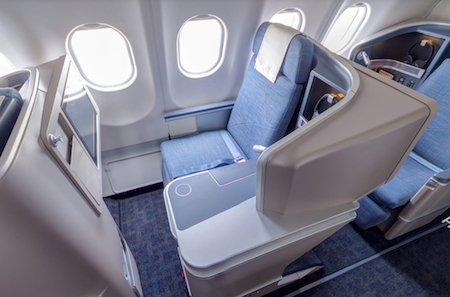
Business class on Philippine Airlines
This choice makes a bigger difference than anything else I can find, so I list it first.
The estimates I have seen suggest the following overhead, but there is some variation based on the plane’s configuration:
- Premium economy: 30–50% more space
- Business class: 200–300% more space
- First class: 250%–400% more space (and can go higher)
If you do buy a premium seat, consider incorporating that overhead into your offsets (see next section).
Offset Properly. Buying offsets is not as reliable a way to reduce your flight emissions as skipping one or more flights, but there are some steps you can take to improve your offsetting: (1) Use a decent flight offset calculator. (2) Account for your seat class. (3) Account for non-CO2 impact. (4) Buy good offsets.
1. If you do a Google search for “carbon footprint calculator”, one of the top results is the EPA’s calculator. Unfortunately, it covers only three things: home energy use, car use, and (strangely) recycling. Take a look at it — it’s kind of fascinating in a “We paid for this?” sense — but don’t use it, since you won’t find air travel there! Virtually any other calculator will have an entry for flights. The top result I get is CarbonFootprint, which works fine, and several airlines have calculators, including United, Delta, and Virgin Atlantic. The calculators I’ve checked generally agree on flight distances and CO2 emissions, so these are all good choices.
2. Next, remember to multiply by the appropriate “premium seating” factor if you are not flying economy and the calculator does not ask you which class you are flying.
3. Third, double your miles to account for non-CO2 emissions. The only calculator listed above that incorporates these is the Carbon Footprint calculator. The Atmosfair calculator does as well. But most will not — they cover only CO2 emissions.
In case you are rolling your eyes at this multiplier, consider the chart below.
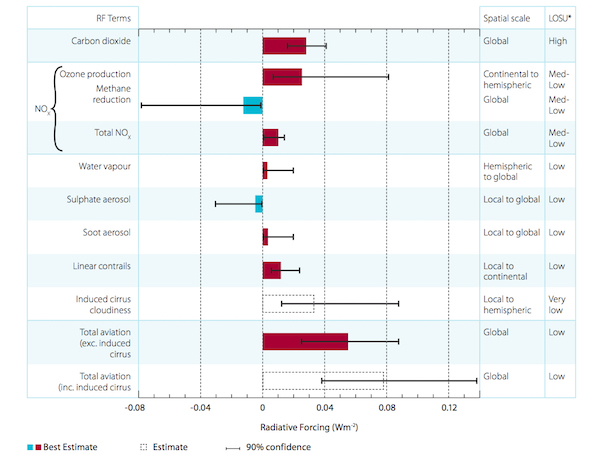
Ways in which aviation warms the planet. Source: CarbonBrief
The topmost red bar shows the impact of a flight’s CO2 emissions. The second-to-last line shows the sum of the other warming (and cooling) impacts except the one just above it (“induced cirrus”), which has very low certainty. You can see that the net effect is twice the size of CO2 on its own. Because of this, a multiplier of 2 to incorporate non-CO2 emissions is generally accepted, though Atmosfair uses a factor of 3 to account for the potential impact of high-elevation flights on cirrus clouds. You can learn more from this CarbonBrief writeup, or see this presentation by an expert in the field from early last year.
4. Finally, purchase quality offsets. I covered that in an earlier post. From what I can tell, the airlines that offer offsets do an okay job selecting them, so you can use those, or purchase some separately if there is a project of particular interest you want to support.
As an example of all this, suppose you are flying round-trip from SFO to London on United to attend your niece’s wedding. You are 6’2” and have a strong preference for business class. Most calculators will tell you that this is about 10,700 miles, with about 1.5 tons of CO2 emissions. You would then multiply by 2.5 for business class, and 2 for non-CO2 emissions, for a total of 7.5 tons of CO2. (1) You look for some Gold Standard offsets that also improve childrens health (e.g., cleaner stoves), which you find for around $10/ton. This costs you about $75, or around 1% of the cost of your business class flight. If you choose to squeeze into Economy, your flight would be much cheaper and your offsets would be around $30, or about 4% of the cost of your flight. (2) These offsets will hopefully reduce CO2 emissions somewhere in the world by the same amount that your flight is adding.
Note: Atmosfair is an interesting carbon footprint calculator. It shows you separate emissions estimates for common airlines, and even allows you to enter the type of plane you are flying. It also does things like apply the non-CO2 impacts only for the high-altitude portions of a flight. But using it to buy offsets can be more expensive, in part because it adds 200% for the non-CO2 emissions instead of the more standard 100%, and in part because the offsets themselves are somewhat expensive. Its estimate for the above business class trip is 7 tons of CO2 and $175 for the offsets. I think it’s a great site to use as a calculator, but you may want to purchase the offsets elsewhere.
Choose Lower Impact Flights. Flights are not all equal. You can lower your flight’s warming impact by avoiding short hops, preferring newer planes, and flying during the day. I’ll take those one at a time.
1. Avoid short hops. As you can see in the chart below, using the red line and the right axis (carbon intensity), a single 3000-mile flight emits less than multiple shorter flights. Two 1500-mile flights might have a carbon intensity of 85, while a single 3000-mile flight might have a carbon intensity of 75, almost a 15% reduction. This is partly due to extra fuel used at takeoff, and partly because less efficient jets may be used for shorter hops. Flying seems to be optimized around “medium-haul” distances of several thousand miles.
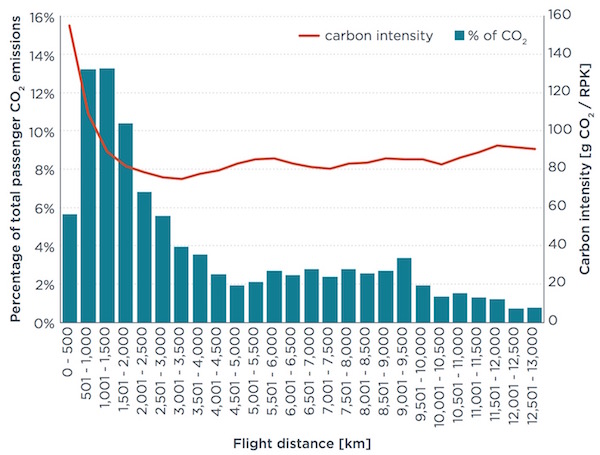
The red line shows the carbon intensity of flights for the year 2018, with shorter flights (to the left) generating more emissions per mile. Source: The International Council on Clean Transportation
2. Fly newer planes. If you look at the data generally, newer planes get around 90 mpg, while older ones get around 75 mpg (per seat). That is a 20% improvement, so not too shabby, but it’s not obvious how to book seats on newer planes. It may be easier to just fly airlines that tend to fly newer planes. The diagram below shows overall fuel efficiency for US domestic operations for 2017–1018.
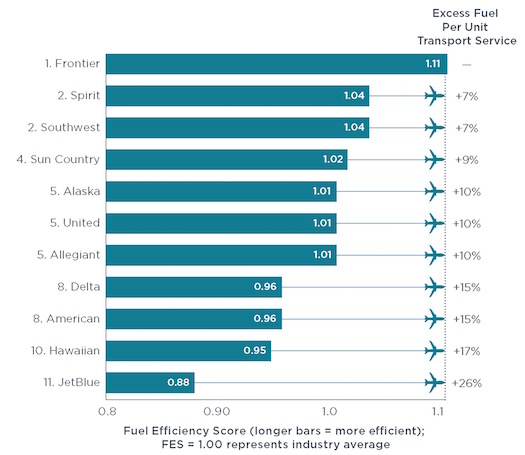
Source: The International Council on Clean Transportation report for 2017–2018
That chart conflates a number of factors, though, including how much premium seating is offered, how many empty seats there are, and how efficient the planes are. This table breaks it down.

Source: The International Council on Clean Transportation report for 2017–2018
You can see that Southwest, for example, is a good option because it has few premium seats and it flies efficient planes. But I would say Hawaiian is also good if you fly Economy.
The chart below shows similar data for a selection of international flights.
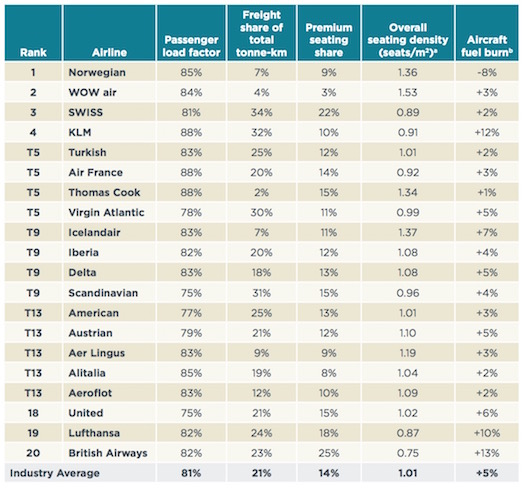
Source: The International Council on Clean Transportation report for 2017
If this seems a little complicated (ahem), the Atmosfair calculator seems to take all of this and more into account, so you could also look there before booking your flight. Going to Hawaii from SFO? It recommends Hawaiian or United, but not Delta. The difference is almost 15%.
3. Fly during the day. This suggestion applies mainly to longer flights (2000 miles or more). Contrails are a big component of the non-CO2 impact of flights at high elevations. They reflect sunlight back up (which is good), but they also reflect heat back down (which is bad). Overall, they have an insulating effect, and that effect is biggest when they aren’t reflecting much sun, which is… at night! A 2006 study reports that although only a quarter of flights are at night, those flights account for 60-80% of all of the contrail warming impact from planes. That same study also indicates that contrails are less likely to form in the warmer summer months, so planning an annual longer-distance vacation in summer rather than winter can help as well.
All that said, some of the above is too complicated for me. But economy seating and offsetting work for me, as well as avoiding short hops and checking Atmosfair. Learning about this also helped me to appreciate the efficiency of more crowded flights, so I won’t mind those as much any more. In the next post on flying, I will review some of the technical innovations in green aviation. Will tech come to the rescue? First, though, I’ll take a detour into something a little more fun that I think many of you will relate to.
Notes and References
1. If you check the Global Carbon Atlas you will see that this one flight is almost a full year’s worth of (consumption) emissions for an average European (8.2 tCO2/person in 2017), or 42% of the emissions of an average American (18 tCO2/person).
2. I suppose another even simpler way to offset is to just purchase offsets worth 5% of your flight price. That would have made for a really short post, though :)
3. Another take on airline brands, besides fuel efficiency, is to look at how much their management seems to care about environmental impact. Are they reporting verified emissions data, setting long-term reduction targets, aligning corporate structure and incentives with climate initiatives, etc? A research institute at the London School of Economics has done a report on that (summarized by CNN, and with a presentation here). They indicate that ANA Group, Delta, Lufthansa, and United have pretty strong management focus on climate impacts. Both Delta and JetBlue recently made some pro-environment announcements, as did United 18 months ago. But Forbes has an interesting analysis of the substance of those promises that I tend to agree with.
Current Climate Data (January 2020)
Global impacts, US impacts, CO2 metric, Climate dashboard (updated annually)
Efforts to inhibit the spread of coronavirus, such as reducing air travel and generally staying at home, are also affecting China’s emissions. The two charts from CarbonBrief below show some relevant indicators. The first shows how coal used for power generation has not bounced back from the annual holiday drop, while the second shows levels of nitrogen dioxide, a byproduct of fossil fuel combustion, similarly staying low over that region.

Coal used for power in China before and after the New Year holiday, with 2019 in red. Source: CarbonBrief

Nitrogen dioxide levels over China have remained low after the New Year holiday. Source: CarbonBrief
Comment Guidelines
I hope that your contributions will be an important part of this blog. To keep the discussion productive, please adhere to these guidelines, or your comment may be moderated:
- Avoid disrespectful, disparaging, snide, angry, or ad hominem comments.
- Stay fact-based and refer to reputable sources.
- Stay on topic.
- In general, maintain this as a welcoming space for all readers.



